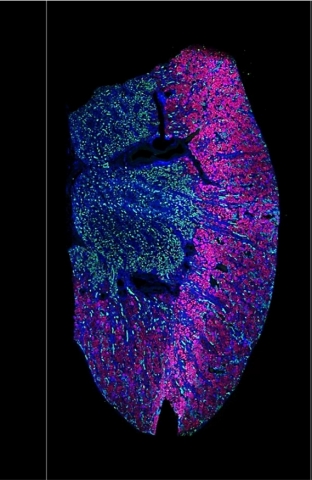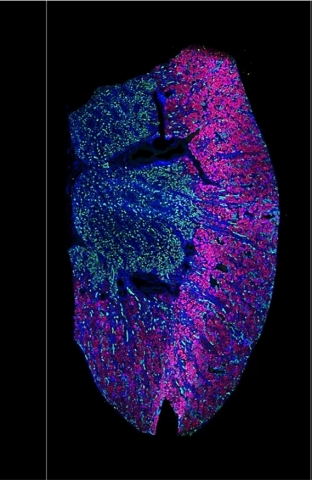SEATTLE--(BUSINESS WIRE)--NanoString Technologies, Inc. (NASDAQ: NSTG), a leading provider of life science tools for discovery and translational research, today announced the launch of the Spatial Organ Atlas, an annotated reference dataset of spatially resolved whole transcriptomes, providing a foundational knowledge base for researchers to quickly discover how organs function in both healthy and disease states, using the GeoMx® Digital Spatial Profiler (DSP).
"The Spatial Organ Atlas maps the whole transcriptomes of the multi-cellular molecular machines that drive organ biology," said Joseph Beechem, Ph.D., chief scientific officer, NanoString. "For example, we have spatially resolved every major ion transporter system in the kidney, recapitulating 50 years of organ research in a single experiment."
As part of the Spatial Organ Atlas initiative, whole transcriptome profiles of Formalin-Fixed Paraffin-Embedded (FFPE) tissues were generated from non-diseased organs, using the GeoMx DSP and Whole Transcriptome Atlas (WTA) assays. The initial datasets include spatial transcriptome profiles of biological replicates for six organs, including the human brain, pancreas, kidney, colon, lymph node, and mouse brain. NanoString plans to add data from additional organs over time and intends for this publicly accessible resource to serve as a reference for understanding organ structure and function.
The Spatial Organ Atlas can be explored on NanoString's website, http://www.nanostring.com/spatial-organ-atlas, through downloadable datasets, including images, sequencing data, and analysis results. In addition, interactive image browsers are provided to narrate whole transcriptome profiling analysis for select organs, beginning with the kidney and pancreas.
"Whole transcriptome profiling of the tubular and glomerular regions in kidney graft biopsies from a patient and normal controls allowed us to unravel previously unappreciated mechanisms of graft response to the alloimmune attack," wrote Paolo Cravedi, M.D., Ph.D., Department of Medicine, Translational Transplant Research Center, Icahn School of Medicine at Mount Sinai, New York, and his colleagues in their recently published paper entitled, "The spatially resolved transcriptional profile of acute T-cell mediated rejection in a kidney allograft."
"Spatial whole transcriptome profiles of histological functional units of organs are promising for devising novel therapeutic strategies in many challenging cancers," said Chris Mason, Ph.D., professor of physiology and biophysics at Weill Cornell Medicine, who is a compensated member of the NanoString Scientific Advisory Board. "There is huge potential for an organ atlas of normal lymph nodes to lay the foundation for improving our understanding of the changes in tumor cells and the local immune response during health and disease, and indeed we have already resolved new pathologies in COVID-19 tissues." Two recent papers in Nature and Nature Communications by Dr. Mason revealed immune cell infiltration and tissue damage in patient autopsies.
The Spatial Organ Atlas is being highlighted during the 2021 ASHG Conference. Three conference posters and several presentations during NanoString-sponsored events will highlight the latest scientific advances using the GeoMx DSP and the development of NanoString's Spatial Molecular Imaging (SMI) technology.
Industry Education Session: Tuesday, Oct. 19 at 2:30 pm ET, "Spatial Organ Atlas: Whole transcriptome spatial profiling of functional substructures in human organs using the GeoMx DSP," will be presented by Joseph Beechem, Ph.D., chief scientific officer, NanoString. Dr. Beechem will provide details of the Spatial Organ Atlas initiative and highlight the latest technological advancements at NanoString.
Industry Solutions - Live CoLab: Wednesday, Oct. 20 at 2:30 pm ET, "Uncovering the interactive molecular networks of the normal lymph node with GeoMx DSP whole transcriptome spatial profiling," will be presented by Chris Mason, Ph.D., Weill Cornell Medicine. This discussion will focus on how Dr. Mason plans to use the Spatial Organ Atlas in his B-cell lymphoma studies.
Industry Solutions – Live CoLab: Thursday, Oct. 21 at 2:30 pm ET, "Spatial whole transcriptional profiling of functional substructures in human organs using digital spatial profiling," will feature a table discussion between Joseph Beechem, Ph.D., and Gary Schroth, Ph.D., distinguished scientist at Illumina. This will be a live discussion focused on spatial omics.
Lightning Talk: Thursday, Oct. 21, at 2:30 pm ET, "The NanoString Spatial Molecular Imager: True single cell, multi-omic, high-plex imaging in FFPE tissue," will be presented by Ian Ross, Product Manager, SMI, NanoString.
GeoMx Poster Presentations: Monday, Oct. 18, from 5:30 – 6:30 pm ET
Spatial whole transcriptome analysis of human kidney histological structures (Poster #3843): Fundamental histological structures of non-diseased kidney nephrons, including glomeruli, glomerular filtration membrane, proximal and distal convoluted tubules, loops of Henle, and collecting ducts, were profiled using the GeoMx WTA (18,000 genes). A total of 14,319 genes were detected in any segment collected, revealing both known biology and new insights into each substructure profiled in situ. In addition, each kidney substructure had enrichment in specific genes and pathways as expected, e.g., ion and metabolite transporters expressed explicitly in proximal and distal tubules, recapitulating 50 years of kidney physiology in a single experiment.
Spatial whole transcriptome profiling uncovers unique functional insights into the histological structures of the human pancreas (Poster #3844): Key histological structures of a non-diseased pancreas, including Alpha cells, beta cells, islets of Langerhans, acini, and ducts, were profiled using the GeoMx WTA. Thousands of genes were detected per region profiled, revealing both known biology and new insights into each substructure profiled in situ. In addition, the initial analysis of a cohort of four pancreas samples shows that regions cluster by type, not by the individual, highlighting the ability of the assay to illuminate the basic biology of these structures.
The Spatial Organ Atlas: Updating our fundamental understanding of tissue architecture with digital spatial profiling (Poster #3839): The Spatial Organ Atlas is the first community-driven project to provide whole transcriptome data generated in-situ from FFPE, non-diseased organs. The 18,500 gene targets map the exact shape of the molecular anatomy of functional histological features. This atlas will serve as a reference for an understanding of organs in health and disease.
To learn more about the Spatial Organ Atlas, visit http://www.nanostring.com/spatial-organ-atlas.
About NanoString Technologies, Inc.
NanoString Technologies is a leading provider of life science tools for discovery and translational research. The company's nCounter® Analysis System is used in life sciences research and has been cited in more than 4,900 peer-reviewed publications. The nCounter Analysis System offers a cost-effective way to easily profile the expression of hundreds of genes, proteins, miRNAs, or copy number variations, simultaneously with high sensitivity and precision, facilitating a wide variety of basic research and translational medicine applications, including biomarker discovery and validation. The company's GeoMx® Digital Spatial Profiler enables highly multiplexed spatial profiling of RNA and protein targets in a variety of sample types, including FFPE tissue sections.
For more information, please visit www.nanostring.com.
NanoString, NanoString Technologies, the NanoString logo, GeoMx, and nCounter are trademarks or registered trademarks of NanoString Technologies, Inc. in various jurisdictions.




